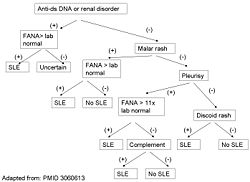Systemic lupus erythematosus
Systemic lupus erythematosis (SLE) is an autoimmune connective tissue disorder. While there is no cure, there have been major advances in its treatment in recent years.
Initial presentation
Symptoms can be diffuse, but one classical sign, not always present, is a "butterfly-shaped" rash centered on the nose.
Diagnosis
Alternative criteria
Recursive partitioning has been used to identify more parsimonious criteria. [1] This analysis presented two diagnostic classification trees:
1. Simplest classification tree: LSE is diagnosed if the patient has an immunologic disorder (anti-DNA antibody, anti-Smith antibody, false positive syphilis test, or LE cells) or malar rash.
- sensitivity = 92%
- specificity = 92%
2. Full classification tree: Uses 6 criteria.
- sensitivity = 97%
- specificity = 95%
Other alternative criteria have been suggested.[2]
Treatment
The beginnings of treatment, in the 1950s, used crude antiinflammatory and immunosuppressants such as ACTH. The core of today's treatment, however, are specific monoclonal antibodies.
References
- ↑ 1.0 1.1 Edworthy SM, Zatarain E, McShane DJ, Bloch DA (1988). "Analysis of the 1982 ARA lupus criteria data set by recursive partitioning methodology: new insights into the relative merit of individual criteria". J. Rheumatol. 15 (10): 1493-8. PMID 3060613. [e]
- ↑ Hughes GR (1998). "Is it lupus? The St. Thomas' Hospital "alternative" criteria". Clin. Exp. Rheumatol. 16 (3): 250-2. PMID 9631744. [e]
